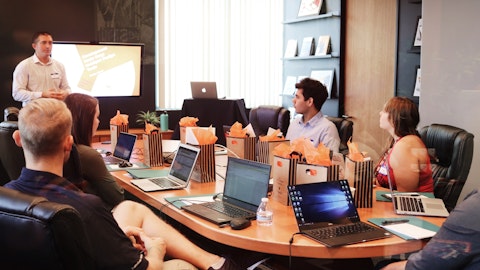Energy Recovery, Inc. (NASDAQ:ERII) Q1 2023 Earnings Call Transcript May 3, 2023
Operator: Greetings, and welcome to Energy Recovery First Quarter 2023 Earnings Call. At this time, all participants are in a listen-only mode. A brief question-and-answer session will follow the formal presentation. As a reminder, this conference is being recorded. It is now my pleasure to introduce your host, James Siccardi, Vice President of Investor Relations. Please go ahead.
James Siccardi: Hello everyone, and welcome to Energy Recovery’s 2023 first‐quarter earnings conference call. My name is Jim Siccardi, Vice President of Investor Relations at Energy Recovery. And I am here today with our Chairman, President and Chief Executive Officer, Bob Mao; and our Chief Financial Officer, Joshua Ballard. During today’s call, we may make projections and other forward‐looking statements under the Safe Harbor provisions contained in the Private Securities Litigation Reform Act of 1995 regarding future events or the future financial performance of the company. These statements may discuss our business, economic, and market outlook, growth expectations, new products and their performance, cost structure, and business strategy.
Forward‐looking statements are based on information currently available to us and on management’s beliefs, assumptions, estimates, or projections. Forward‐looking statements are not guarantees of future performance and are subject to certain risks, uncertainties, and other factors. We refer you to documents the company files from time to time with the SEC, specifically the company’s Form 10‐K and Form 10‐Q. These documents identify important factors that could cause actual results to differ materially from those contained in our projections or forward‐looking statements. All statements made during this call are made only as of today, May 3, 2023, and the company expressly disclaims any intent or obligation to update any forward‐looking statements made during this call to reflect subsequent events or circumstances, unless otherwise required by law.
At this point, I will turn the call over to our Chairman, President and Chief Executive Officer, Bob Mao.
Bob Mao: Thank you, Jim. Good afternoon and thank you everyone for joining us today. Let me start with the latest updates in our Water business. In desalination, we continue to be on track for this year. The Middle East remains the foundation of our desalination sales, but as water scarcity continues to increase, other regions are clearly emerging. We’ve previously spoken on the potential of Asia a number of times, which remains true. However, we have not spoken in much detail about North African countries, such as Morocco, Egypt, and Algeria, who are showing real promise as well. Morocco is increasingly turning to desalination to ease the impact of its multi‐year drought, which is the worst the country has seen in 40 years.
Reservoir levels in Morocco have fallen by half from about 62% in 2013 to 32% in 2022. Water supplies in Morocco have fallen below 650 cubic meters per capita from 2,500 in 1960 and are expected to decline throughout this decade. Today, Morocco relies on its surface and underground water for nearly all its water needs, but these sources are quickly drying up. They have recently announced aggressive plans to invest in desalination in the coming years. We are already seeing growth in revenue from Morocco in 2023 and 2024 and expect to see that growth accelerate considerably by 2025 to 2026. We have previously discussed Egypt’s plan to invest in desalination as a response to the damming of the Blue Nile by Ethiopia. In December of last year, Egypt announced plans to award 21 additional desalination plants this year, to be commissioned in the coming four years, totaling 3.3 million cubic meters of daily production in the first phase of a program that could ultimately reach nearly 9 million cubic meters by 2050.
Despite some of their recent macroeconomic difficulties, we see considerable potential in Egypt, starting in strength in 2024 and accelerating through 2026. In response to its own water crisis, Algeria has a goal of meeting 50% of their water demand with desalination by 2030. Five plants in the coming years could increase capacity by over 1.5 million cubic meters of production per day. We are currently bidding on each of these projects, and they could exceed $20 million in revenue this year. These three countries simply highlight the growing need for desalination to combat the increasing scarcity of water around the globe. Despite all their efforts building dams, working on water re‐use, reducing water usage, as well as other initiatives, desalination remains the single most reliable source of water that is decoupled by drought and unpredictable weather patterns.
It is this types of decision being made, by countries all over the world that underpins our confidence in desalination in the coming years. As interest in desalination grows, we are actively seeking ways to serve potential new, or adjacent markets as we discussed last call, such as brackish desalination. But as we expand into a wider subset of smaller desalination and wastewater projects, the average size of each project will become smaller compared to our traditional mega project growth trajectory that we have ridden the past decade. Increasing volume across a larger number of smaller projects, and many new customers, means we must look at new ways to serve our customers more efficiently, as well as to expand our sales reach. As an example of our new focus, we recently launched our Power Model Pro platform, a powerful and easy‐to‐use cloud‐based configurator tool that enables the optimization of desalination and industrial wastewater hydraulic pumping systems.
This platform allows customers to design and select the optimal Energy Recovery products, project equipment performance, and model energy consumption for specific projects. We believe this tool will prove very beneficial to our smaller OEM customers and will help enable continued revenue growth in this vertical channel. Now, let’s turn to wastewater. We are excited about the evolution of our pipeline in wastewater. We are currently tracking potential projects in over 20 different industries across multiple countries around the world, for potential shipments in 2023 and 2024. China and India remain the top two countries of focus. However, the experience and knowledge we gained in these two countries, combined with our new product offerings, is now allowing us to target other regions.
We now have a growing pipeline in North America, Europe, the Middle East, and South America. Industries span from our growing lithium battery market to chemical manufacturing, textiles, mining, agriculture, and municipal wastewater. To respond to the volume of potential projects we are seeing, we are beginning to make significant additions to our sales teams in China and India, and we are beginning to look at expanding our team in the Americas. These increases should help to maintain the momentum we are seeing in this market. We must remain on our targeted growth curve in the coming years, and expand that curve, if possible, as we continue our aggressive push over the next three years. Now, let’s turn to CO2. The first quarter was a milestone one for our CO2 business.
First, we signed and announced our first exclusive distribution agreement with the Belgium company Fieuw Koeltechniiek. Second, Epta Group, our initial European partner, and the Italian independent global leader in commercial refrigeration, introduced their XTE product line. The XTE line specifically incorporates our PX G1300 in order to cut energy consumption and enhance the performance of Epta’s systems. Epta introduced the XTE at EuroShop, one of the key industry trade shows that occurs every couple of years in Germany. According to the Spanish food distribution publication INDISA, the XTE was one of the great attractions for attendees and helped lead to a flood of activity from refrigeration manufacturers, contractors, and grocery stores at our booth.
The validation by both OEMs of our technology is an important and key step as we evolve this business from an idea to a commercial success. Building on this momentum, we believe we are on-track to get deployments into additional supermarket chains this year, and in multiple countries throughout Europe and North America. As I said last quarter, these initial deployments are critical to further confirming our addressable market and drive to volume sales in 2024. As our PX becomes better known, we are finding new applications for our product within and outside of the supermarket chain. As an example, we have spoken on several occasions about how the PX will be applicable to many other cooling applications, such as in the industrial market. A new deployment in Europe of multiple PX G by our partner Fieuw should be commissioned this summer at a manufacturing facility in the food industry.
This opens a new channel for us to grow our PX G sales in the coming years, and we are now beginning to evaluate the likely considerable potential of this market. We do not believe this is where the versatility of the PX G ends. Every such move into a new market will allow us to further build and collect data and accelerate market adoption of our technology. On our last call, I discussed the fact that last summer some supermarkets actually shutdown due to unexpected and historic high temperature spikes and the strain placed on their cooling systems. The unpredictability of weather, and the increasing chance of repeated high temperature spikes, means that supermarkets will have an increasingly difficult time building refrigeration systems that are future proof in our new climate reality.
Our PX G provides one answer to this growing problem, helping to ensure that these systems can handle these new unpredictable temperature spikes. If a store can avoid closing, that provides immediate value on their purchase of a PX G, while also protecting their operating margin and allow them to sleep well at night. A Canadian supermarket chain who was forced to close some of their stores last year, showed interest in using the PX G as a backstop to protect them against their own system failures on the hottest days. Our PX G is scheduled to be installed at one of their locations early this summer. Interestingly, many of the locations in which we are installing our PX G’s are retrofits of existing systems. Some of you may remember that in 2021 we initially began talking about the PX G as a retrofit, or bolt‐on as we termed it then, to existing systems.
For a period, we had to walk away from this concept as we were not able to incorporate our PX G at a low enough price point on our own. However, with the experience and relationships we have gained over the past 18 months, we may have now found a reasonable path to potentially turn a previously unreachable market into a low‐hanging fruit opportunity. We are seeing considerable interest by both OEMs and contractors in assisting us in tackling this market, which would potentially allow us to address the estimated more than 40,000 CO2 refrigeration systems already installed throughout Europe and North America. This retrofit market could be a critical one for us to drive up demand, and enter the market, quickly. Existing grocery store chains using those previously installed CO2 refrigeration racks, such as Vallarta here in California, have seen first‐hand how the combination of elevated ambient temperatures and high energy costs can significantly erode operating margins.
This became an even more critical issue in 2022 following the onset of war in Ukraine and the subsequent spike in energy costs in Europe. We believe the time is right now to drive PX G deployment when grocery chains can realize the greatest benefit and fastest payback to their investment in our technology. However, volume deployment provides an additional challenge: product support. Any new technology introduced to a large mature industry is likely to face unexpected issues during the adaptation stage. Energy Recovery must ensure that the transition occurs as smoothly as possible. As such, we are hiring and training the field engineering and technician staff we need to support this roll-out. We are also focused on developing training for external service technicians on the PX G in order to bring our contractor and OEM partners up to speed on the PX G as quickly and painlessly as possible.
The faster we can avoid any potential bumps in our road, the quicker we believe the PX G will be perceived to be the answer to the operating expense concern of the grocery store end‐users. In short, we continue to push hard into this new market, and remain confident in our ability to deliver. We look forward to providing new updates in our July call. With that, let me hand the call over to Josh.
Joshua Ballard: Good afternoon, everyone. We generated revenue within guidance, at $13.4 million. Of that revenue, 1.4 million came from industrial wastewater, and a little over a 100,000 from CO2, with the balance from desalination. OEM and aftermarket revenues made up 74% of desalination revenue in the first quarter, which is contrary to a typical quarter, but simply highlights the heavy weight of mega project shipments planned in the second half of the year. We believe we will achieve the upper end of our guidance for the second quarter, and our guidance for the year remains unchanged. Let’s talk briefly about where we stand on our path to our $200 million desalination revenue target in 2026. Our long‐term growth outlook remains strong, despite seeing some short‐term fluctuations during this global economic uncertainty as we’re seeing this year.
Based on this year’s guidance, we would need to average 16% to 17% growth over the three years from 2024 to 2026 to achieve $200 million in 2026. This is similar growth to what we’ve seen over the past five years. Where we sit today, given our pipeline, the fundamentals of the overall market, and the strength of our product set, we believe we can still achieve that target. As we look to the nearer future, we remain comfortable in our 2023 outlook, but are paying close attention to risks in the market that could affect our 2024 revenue. In particular, rising costs and the current economic uncertainty seem to be delaying the tendering of a few mega projects to EPCs. Any prolonged delays could mean that one or more of those projects may slip into 2025 or later.
It’s still early, but we want to be transparent about potential near‐term risks. We will keep you apprised as the year progresses. This potential near‐term risk does not seem to be a broader trend in the mega project markets, nor is it being seen in our smaller OEM project or aftermarket spaces, or in our wastewater business. Now, let’s turn back to first quarter results where our water gross margin was 62%, in-line with guidance from last quarter. Gross margin was impacted by the outsized weight of the OEM and aftermarket channels, resulting in fewer pressure exchangers shipped as a percentage of overall revenue. Of note, racks and manifold made up about 8% of water sales this quarter, which added to the temporary margin decline. We should see a return to our guided range of 64% to 66% in the second quarter, and throughout the remainder of the year.
You may also note a negative gross profit margin in our emerging technology segment, which is temporary as we launch this new business. We are incurring higher costs as we transition from an engineering supported launch to a commercially driven product this year. Margin should begin to normalize throughout the year as we begin to purchase and produce at higher volume. It’s early to guide a margin on this business this year, but I will be sure to provide more color as the year progresses. Let’s now turn to operating expenses. We are showing a 10% increase in OpEx over Q1 2022 levels, but a 6% increase over Q4 last year. As expected, and communicated, this quarter‐on‐quarter sustained growth in OpEx spend is largely happening in sales and marketing, which grew 12% over Q4 last year.
We experienced an increase in R&D as compared to the prior quarter, however this increase is more temporary in nature and simply tied to the timing of specific project spend. Overall R&D spend will likely remain flat for the full-year, as communicated last quarter, while growth in sales and marketing should continue to accelerate throughout the year. OpEx is generally moving in-line with expectations, and we have no changes to our guidance for the year at this time. However, we continue to evaluate spend to ensure that we are investing where needed to keep growth targets on track. As expected, and as we communicated the preceding two quarters, we did experience a loss in Q1. This is no surprise based on the level of revenue and our generally fixed OpEx. Based on our current projections, we now anticipate we should achieve close to a breakeven second quarter.
We expect to see a significant uptick in profitability from increased sales in Q3 and Q4, which should balance out the year. Despite the loss this quarter, we showed healthy increases in operating cash flow, and overall cash levels increased by almost $9 million, or about 9.5%, following better than expected customer receipts in the quarter. Additionally, while we saw overall growth in inventory levels, raw material inventories declined in the first quarter. As a reminder, inventory levels should grow in the second quarter and could somewhat exceed $40 million, driven by increased finished good balances. We anticipate a rapid drop in finished goods inventory in the second half of the year as shipments pick up, which should bring our inventory levels more in-line with where we ended 2022.
As I mentioned last quarter, the one factor that could change this trajectory could be PX G inventory needs, which we’ll continue to assess. To wrap up, this was a fairly quiet quarter from a financial perspective. We remain on track with our 2023 projections from last year and will continue to keep you apprised of our longer revenue outlook as the year progresses. Let’s move to Q&A.
Q&A Session
Follow Energy Recovery Inc. (NASDAQ:ERII)
Follow Energy Recovery Inc. (NASDAQ:ERII)
Operator: Thank you. First question comes from Ryan Pfingst with B. Riley Securities. Please go ahead.
Ryan Pfingst: Hi. Good afternoon, guys. For the 200 million that you referenced, Bob, potentially coming from those projects, in Algeria, would that be upside to guidance for this year or is that somewhat baked in here?
Bob Mao: No, that’s included in our forecast.
Ryan Pfingst: Okay. And to kind of piggyback off that, could you talk a little bit about visibility into the back half? It looks like the year is off to a good start in terms of meeting your expectations, but just wondering if you could provide any color as to how much of the expected 2023 revenue might come from orders that you already have in-hand whether that’s some most or close to all?
Joshua Ballard: I can answer that, Ryan. It’s Josh. I mean, as is typical, we have good visibility from our mega project perspective. So, we haven’t necessarily signed all those projects, but everything is very either signed or very progressed in negotiations and so forth. So, we’ll be wrapping that up sooner rather than later for the year, but OEM and aftermarket, we certainly never signed everything this soon. Their a much shorter length in time in terms of the negotiated project and so forth, six months or less typically. So, we’ll still be signing those projects. So, I wouldn’t say we have the entire year, but in terms of pipeline, our existing backlog and where we see the second quarter and so forth going forward, we feel pretty confident in this year.
Ryan Pfingst: Great. Thanks guys. I’ll hop in the queue.
Operator:
Operator: Next question comes from Pavel Molchanov with Raymond James. Please go ahead.
Pavel Molchanov: Thanks for taking the question and interesting comments about the opportunity in Morocco. When I look geographically at your desalination business mix. It’s basically two-thirds Middle East, only 20% Asia. As we’re watching these record heat waves in places like China, Thailand, Vietnam, Vietnam I’m curious if you’re getting more incoming interest from that part of the world versus the more traditional Middle Eastern market?
Bob Mao: Not yet seeing any more than we already anticipated. China as we talked about last time, this 14th five-year plan is the first time China officially recognized a diesel as an alternative to address the water stress, whereas China traditionally relied on sending excess water from the South via to the North. Of course, this past summer, maybe that’s what you’re referring to, a drought in the Sichuan along the Yangtze River, but it’s a planned economy. Changing plans takes a little time. , we have not seen any uptick that we didn’t anticipate.
Pavel Molchanov: Okay. Let me follow-up on the refrigeration. I think you said, breakeven for this product in the second quarter. Is that faster than what you originally anticipated?
Joshua Ballard: No, we didn’t say breakeven for refrigeration that was for the business overall, Pavel, based on where we’re seeing the revenues come-in in Q2 at the higher end of our forecast.
Pavel Molchanov: Okay. Understood. So maybe, I guess specific to refrigeration, I think last year you were suggesting that it should reach breakeven sometime in 2023, how likely is that looking?
Bob Mao: It’s probably challenging, due to the fact that the whole refrigeration industry is facing a demand far exceed the supply for traditional configurations. So, therefore the OEMs have their hands full – more than their hands full shipping the CO2 without our energy saving devices. And this is an issue, which means we have to redouble our sales effort to generate greater demand pool. So that there will be end users start demanding having our PX energy saving devices. For example, the Canadian supermarket who is installing this – our PX to address the heatwave pipes, the spikes, I’m sorry, was an end user generate demand, not an OEM pushed solution. And of course, this increases in the short-term go to market expense.
Pavel Molchanov: Got it. Thank you very much.
Operator: Okay. There are no further questions at this time. I would like to turn the floor over to James for closing remarks.
James Siccardi: Thank you, Stacy, and thank you everyone for joining us today. Have a good evening.
Operator: This concludes today’s teleconference. You may disconnect your lines at this time, and thank you for your participation.





